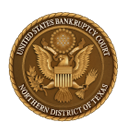You are here
FAQs
-
How can I continue/postpone my 341 Meeting of Creditors?
To postpone a scheduled 341 meeting, you must contact the assigned Trustee to make the request. If approved, the Trustee will file the appropriate notice with the Court.
-
Does your circuit have a Bankruptcy Appellate Panel?
Our circuit does not have a Bankruptcy Appellate Panel. Please see the 8000 series of the Bankruptcy Code and Rules and Local Bankruptcy Rules for more information.
-
How do I prove I have not filed for bankruptcy?
In order for the clerk's office to certify you have not filed for bankruptcy in the Northern District of Texas Bankruptcy Court, the alleged debtor must file an Application for Search of Bankruptcy Records. A search of court records, based on the social security number provided, will be performed and if a match is not found then the court will certify the document and append the court's seal. There is a $31 search fee plus $11.00 for certification.
The applicant will be responsible for communicating with the credit bureaus to have the erroneous reporting resolved.
-
If an ECF filer has made all outstanding payments and still does not get any menu options, what do they need to do?
In order to restore the menu options after reconciling the ECF fees, filers can either refresh the page and/or clear the cache.
For a quick fix, click on Bankruptcy and then right click anywhere inside the blank screen and select refresh the page.
If you continue to get a blank screen, then the other option is to clear the Cache and delete the cookies and temporary files by following the steps below:
If using Internet Explorer:
1. Go to menu of the browser
2. Click on Tools/Internet Options.
3. Click on the button Delete Cookies and then click on the button Temporary Internet files.
4. Log out of ECF and log back in.
5. Refresh the page to restore all menu options.
-
What is a Trustee?
A trustee is a person who administers bankruptcy cases. The trustee does not represent the debtor or any individual creditor and cannot give legal advice. Rather, the trustee has independent rights and duties that are set forth in the Bankruptcy Code. In a chapter 7 case, the trustee may take possession of the debtor's assets, sell them, and distribute the proceeds to creditors. In a chapter 13 case, the trustee administers the debtor's plan, and pays the creditors. The trustee will also oversee the first meeting of creditors.
-
What is the difference between Chapters 7, 11 and 13?
Chapter 7: The chapter of the Bankruptcy Code providing for "liquidation," ( i.e., the sale of a debtor's nonexempt property and the distribution of the proceeds to creditors.)
Chapter 11: The chapter of the Bankruptcy Code providing (generally) for reorganization, usually involving a corporation or partnership. (A chapter 11 debtor usually proposes a plan of reorganization to keep its business alive and pay creditors over time. People in business or individuals can also seek relief in chapter 11.)
Chapter 13: The chapter of the Bankruptcy Code providing for adjustment of debts of an individual with regular income. (Chapter 13 allows a debtor to keep property and pay debts over time, usually three to five years.)
-
A person/company that owes me money recently filed for bankruptcy. How do I file a Proof of Claim?
The Proof of Claim form (Official Court Form B410) can be found on our website at www.txnb.uscourts.gov . Once you have filled out the form, you may file it using the ECF system, electronically right from our website, or you may mail it to the Court for filing.
Related website links:
